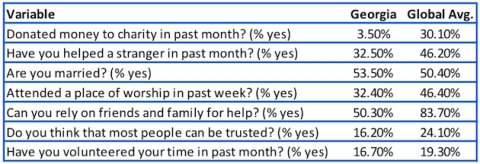 31
მაისი
2023
31
მაისი
2023
ISET ეკონომისტი
 ორშაბათი,
03
დეკემბერი,
2012
ორშაბათი,
03
დეკემბერი,
2012

 ორშაბათი,
03
დეკემბერი,
2012
ორშაბათი,
03
დეკემბერი,
2012
A few days after the beginning of the August 2008 war with Russia, I found myself on an epic journey through Kvemo Kartli and the volcanic plateau of Samtkhe-Javakheti to Turkey. In an effort to take my family to safety, I was driving a fully-loaded off-road vehicle on what was marked on my map as a “road” from Tbilisi via Tetri Tskharo and Tsalka to Akhaltsikhe. This journey of 270 km took about 36 hours, including one hard-to-forget night at a “hotel” in Tsalka (yes, there was and still is such an establishment in Tsalka!). Ok, I admit to taking a little detour and spending half a day for sightseeing in Vardzia. Still, very large portions of the “road” after Koda (30km from Tbilisi) did not exist, or, still worse, appeared to have been bombed by the Luftwaffe during WWII (and never repaired).
Repeating the same journey in 2012 was a totally different experience. The whole trip, including a 10-minute nostalgic stop in the aforementioned Tsalka “hotel”, took less than 4 hours at leisurely speeds. What happened between my two observation points in 2008 and 2012 was no miracle, but the Samtskhe-Javakheti road rehabilitation project. At $209 million in U.S. (taxpayer) dollars, this was the largest investment by the Millennium Challenge Corporation (MCC) in Georgia implemented after August 2008 over a period of about two years. Certainly a great success, at least judging by my before-and-after travel experience.
Now, since our main interest in this column is in Georgia’s economic development, we asked ourselves the following question: what was the impact of this road on the livelihoods of people in the Samtskhe Javakheti region? While there are many aspects of livelihoods that we are not able to examine for lack of reliable data, what we can do is look at what happened to household incomes in the affected (“treated” in the professional impact evaluation jargon) region.
Monthly income (GEL) per household in Georgia’s regions, 2009-2011 (sorted by cumulative change)

The results are staggering. In 2009-2011, household incomes grew in all Georgian regions, yet, Samtskhe Javakheti experienced the highest income increases in both years under examination: 38% and 20% in 2010 and 2011, respectively. As a result, in just two years, this – until recently isolated – region registered a cumulative income growth of 66% (well more than twice the average rate of income growth (29%) for all other regions!) and went from 5th to 1st in income per the household ranking of Georgian regions. While not all of this improvement could and should be attributed to the MCC road project, there is no doubt in my mind that this investment has had a major positive impact.
There is one more point I would like to make in conclusion. The income and welfare gains Samtskhe Javakheti experienced during the past three years are mainly the result of better access to the more lucrative Tbilisi market. The improved ability to transport and sell agricultural products (dairy, meat, potatoes) in Tbilisi was evidently a great boost for the Samtskhe Javakheti farmers (farming is the main occupation of the predominantly Armenian population of the region). With access to a larger market, local farmers were able to scale up their businesses by bringing into circulation and cultivating additional land, investing in infrastructure and machinery, and increasing their dairy and beef cattle herds.
The new road may have had other positive impacts by increasing the flow of tourists and transit traffic that the locals could service, by generating temporary construction-related jobs, and by providing the possibility to commute on a daily basis to Kvemo Kartli and Tbilisi in the low agricultural season. Yet, there is one way in which Samtskhe Javakheti is yet to benefit from a better connection to the Georgian mainland. The region’s GDP per capita performance – that is counting both salaries and profits by local firms that may or may not be passed onto local households – remains dismal due to its almost exclusive specialization in agriculture.
Whatever the virtues of smallholder agriculture, it cannot compete with manufacturing or the banking sector on labor productivity (i.e. output per worker). The small population size of Samtskhe Javakheti, especially in the more elevated part of the plateau, does not bode well for large-scale investment in manufacturing in the absence of “nudging” by the Georgian policymakers. Yet, investment in light industry, such as food processing, would be needed for this region to attract (cheap) labor from the neighboring regions (e.g. Kvemo Kartli), and move to the next level of economic development.





